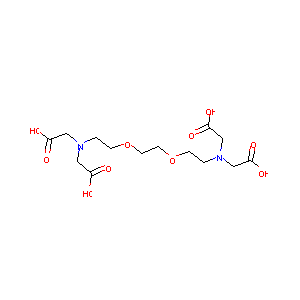Details of the Drug
General Information of Drug (ID: DMW9MRO)
| Drug Name |
EGTA
|
||||||||||||||||||||||
|---|---|---|---|---|---|---|---|---|---|---|---|---|---|---|---|---|---|---|---|---|---|---|---|
| Synonyms |
EGTA; 67-42-5; Egtazic acid; Ethylenebis(oxyethylenenitrilo)tetraacetic acid; Gedta; Ebonta; 6,9-Dioxa-3,12-diazatetradecanedioic acid, 3,12-bis(carboxymethyl)-; 1,2-Bis[2-[bis(carboxymethyl)amino]ethoxy]ethane; Ethylene Glycol Tetraacetic Acid; H4egta; Egtazic acid [USAN:INN]; Ethylene glycol bis(2-aminoethyl ether)-N,N,N',N'-tetraacetic acid; NSC 615010; Acide egtazique [INN-French]; Acido egtazico [INN-Spanish]; Acidum egtazicum [INN-Latin]; Ethylene glycol-bis(2-aminoethylether)-N,N,N',N'-tetraacetic acid; Ethylene glyc
|
||||||||||||||||||||||
| Indication |
|
||||||||||||||||||||||
| Drug Type |
Small molecular drug
|
||||||||||||||||||||||
| Structure |
 |
||||||||||||||||||||||
| 3D MOL | 2D MOL | ||||||||||||||||||||||
| #Ro5 Violations (Lipinski): 3 | Molecular Weight (mw) | 380.35 | |||||||||||||||||||||
| Logarithm of the Partition Coefficient (xlogp) | -6.2 | ||||||||||||||||||||||
| Rotatable Bond Count (rotbonds) | 17 | ||||||||||||||||||||||
| Hydrogen Bond Donor Count (hbonddonor) | 4 | ||||||||||||||||||||||
| Hydrogen Bond Acceptor Count (hbondacc) | 12 | ||||||||||||||||||||||
| Chemical Identifiers |
|
||||||||||||||||||||||
| Cross-matching ID | |||||||||||||||||||||||
Molecular Interaction Atlas of This Drug
 Drug Therapeutic Target (DTT) |
|
||||||||||||||||||||||||||||||||||||||||||||||||||||||||
|---|---|---|---|---|---|---|---|---|---|---|---|---|---|---|---|---|---|---|---|---|---|---|---|---|---|---|---|---|---|---|---|---|---|---|---|---|---|---|---|---|---|---|---|---|---|---|---|---|---|---|---|---|---|---|---|---|---|
 Drug Off-Target (DOT) |
|
||||||||||||||||||||||||||||||||||||||||||||||||||||||||
| Molecular Interaction Atlas (MIA) | |||||||||||||||||||||||||||||||||||||||||||||||||||||||||
References
